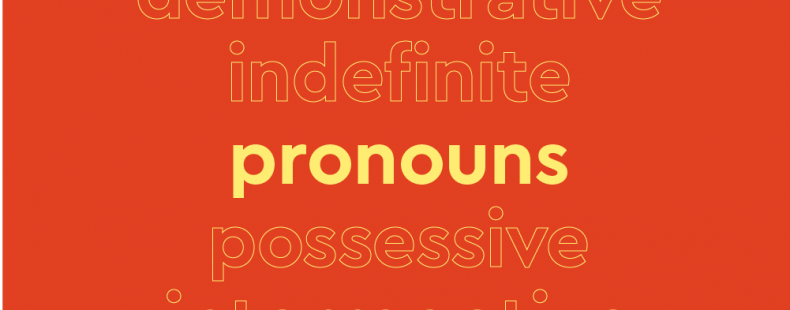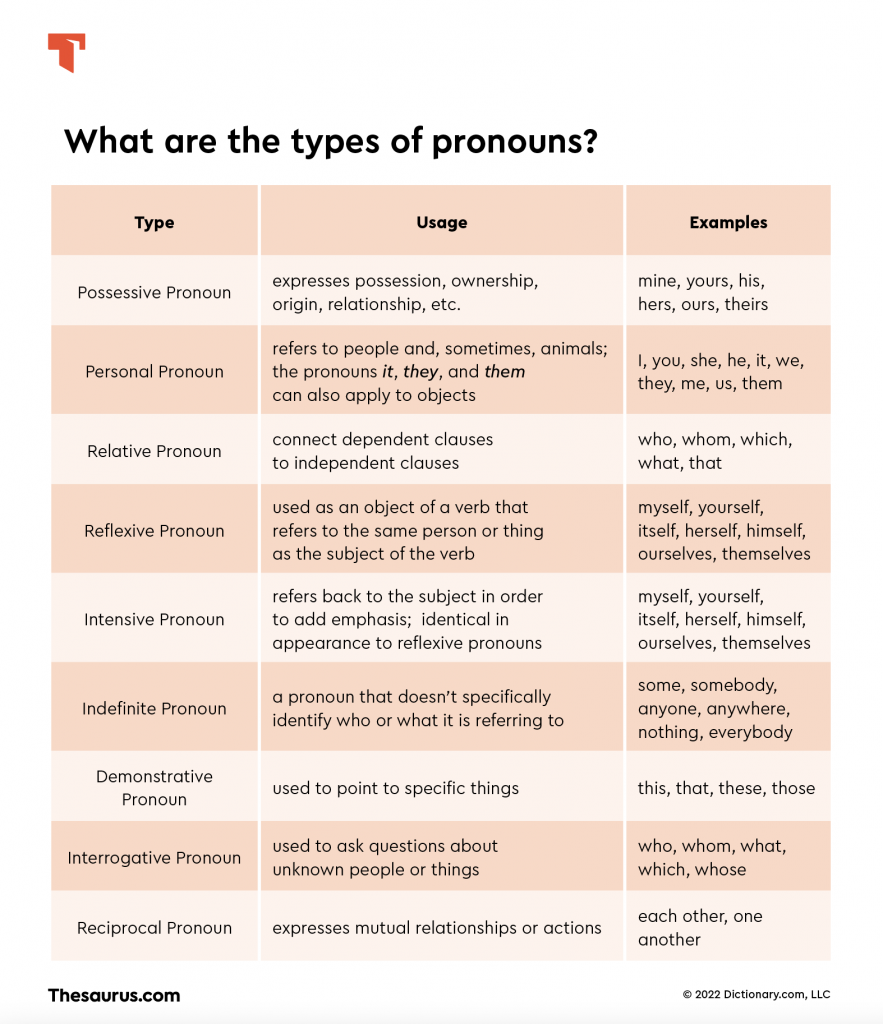Nouns do a lot of work in our sentences. They fulfill the important jobs of acting as subjects and objects. Sometimes, though, a noun needs a break or there’s not a noun that perfectly suits a sentence. When nouns need a helping hand, who are they going to call? No, not ghostbusters (that’s still a noun)—they call on pronouns.
Pronouns can do all of the jobs that nouns do and many of them are shorter and more versatile. Pronouns let us say things like I am proud of myself or It is time to ask somebody for help. Pronouns are a major part of speech and correctly using them will drastically improve your speech and writing.
What is a pronoun?
A pronoun is a word that can replace a noun in a sentence. The noun that is replaced by a pronoun is called an antecedent. For example, in the sentence I love my dog because he is a good boy, the word he is a pronoun that replaces the noun dog.
Generally speaking, pronouns allow us to shorten our sentences and make them sound less repetitive. For example,
- The construction workers are building the office. The construction workers are making good progress. The construction workers should finish the project in no time.
- The construction workers are building the office. They are making good progress. They should finish the project in no time.
You can see that the second set of sentences is both shorter and sounds less repetitive than the first set of sentences.
⚡️ Pronoun quick tip
Grammatically, pronouns function much like nouns: they can be used both as subjects and objects; they refer to people, places, and things; they can be singular or plural; and they can be modified by adjectives. The “noun” in pronoun will help you remember that pronouns behave much the same way that nouns do.
Pronoun list
- He
- It
- You
- I
- They
- We
- Who
- Him
- Them
- Whoever
- Anyone
- Something
- Nobody
We use a bunch of different pronouns in our writing and in speech. Listed below are just some of the pronouns that we use every day:
- I
- me
- you
- he
- she
- it
- we
- they
- us
- them
- who
- what
- this
- that
- anyone
- nobody
- something
Pronoun examples
The following examples show how we use pronouns in sentences.
- We looked for Britney at her house, but she wasn’t there.
- I took my car to the mechanic to get it fixed.
- This is the best birthday ever!
- Someone donated $500 to our charity.
- Andy thinks that mayonnaise goes well with anything.
Types of pronouns
There are many different types of pronouns that we use in writing and speech. For now, we will briefly look at each of these different types. If you want to explore each one in more detail, we have provided an extensive guide to each type of pronoun in the links below:
- Possessive pronouns
- Personal pronouns
- Relative pronouns
- Reflexive pronouns
- Indefinite pronouns
- Demonstrative pronouns
- Interrogative pronouns
- Intensive pronouns
- Reciprocal pronouns
Common types of pronouns
Possessive pronouns
A possessive pronoun is a pronoun that expresses possession, ownership, origin, relationship, etc.
Possessive pronoun examples
- mine, yours, his, hers, ours, theirs
Possessive pronouns used in sentences
- That toy on the shelf is mine.
- All of the houses in our neighborhood look the same, but ours is the only one with a satellite dish.
- Wendy and Ronald separated the french fries into two piles: the left one was hers and the right one was his.
Personal pronouns
Personal pronouns are pronouns that we use to refer to people and, sometimes, animals. The pronouns it, they, and them can also apply to objects.
Personal pronoun examples
- I, you, she, he, it, we, they, me, us, them
Personal pronouns used in sentences
- I am afraid of mice.
- The toaster gets really hot when it heats bread.
- My cats are friendly, so you can safely pet them.
Relative pronouns
Relative pronouns connect dependent clauses to independent clauses.
Relative pronoun examples
- who, whom, which, what, that
Relative pronouns used in sentences
- I need to find a person who can read Swedish.
- She doesn’t want to eat a meal that is too spicy.
- This book, which ends on a cliffhanger, is really exciting.
Reflexive pronouns
A reflexive pronoun is a pronoun used as an object of a verb that refers to the same person or thing as the subject of the verb.
Reflexive pronoun examples
- myself, yourself, itself, herself, himself, ourselves, themselves
Reflexive pronouns used in sentences
- Ken looked at himself in the mirror.
- I like to cheer myself up with desserts.
- The silly clowns made fools of themselves.
Intensive pronouns
Intensive pronouns refer back to the subject in order to add emphasis. Intensive pronouns are identical in appearance to reflexive pronouns.
Intensive pronoun examples
- myself, yourself, herself, himself, itself, ourselves, themselves
Intensive pronouns used in sentences
- I built my house myself.
- The children made the cookies themselves.
- Often, the stress of giving a speech is worse than the speech itself.
Indefinite pronouns
An indefinite pronoun is a pronoun that doesn’t specifically identify who or what it is referring to.
Indefinite pronoun examples
- some, somebody, anyone, anywhere, nothing, everybody
Indefinite pronouns used in sentences
- This note could have been written by anybody.
- Someone ate my lunch.
- The water splashed everywhere.
Demonstrative pronouns
Demonstrative pronouns are used to point to specific things.
Demonstrative pronoun examples
- this, that, these, those
Demonstrative pronouns used in sentences
- This is my favorite shirt.
- I don’t know what that is, but it definitely isn’t friendly.
- I need you to fix these.
Interrogative pronouns
Interrogative pronouns are pronouns used to ask questions about unknown people or things.
Interrogative pronoun examples
- who, whom, what, which, whose
Interrogative pronouns used in sentences
- Who wrote this letter?
- What is an amphibian?
- Which is the correct answer?
Reciprocal pronouns
Reciprocal pronouns express mutual relationships or actions.
Reciprocal pronoun examples
- each other, one another
Reciprocal pronouns used in sentences
- My sister and I love each other.
- The members of the team support one another.
- The two fishermen love to compete with each other.
Singular and plural pronouns
Like nouns, pronouns can either be singular or plural.
Singular pronouns
Singular pronouns refer to a single person or thing. Like singular nouns, singular pronouns must use singular verbs.
Singular pronoun examples
- I, he, she, it, one, this, someone, something, anyone, nobody
Singular pronouns used in sentences
- Melanie is so good at movie trivia that she never gets a single question wrong.
- Somebody is standing next to the window.
- This is the best cake I have ever eaten.
Plural pronouns
Plural pronouns refer to multiple people or things. Plural pronouns must use plural verbs.
Plural pronoun examples
- we, they, us, them, ourselves, themselves, those, these, many, several, others
Plural pronouns used in sentences
- We go to the gym every day.
- These paintings aren’t as old as those are.
- Several of the ducks know that children like to feed them bread.
How to reach pronoun agreement
When using a pronoun, it must agree in number with its antecedent. This means that a singular noun can only be replaced by a singular pronoun, and a plural noun can only be replaced by a plural pronoun. Take a look at the following two examples:
- The basketball rolled until it hit the door.
- The basketball rolled until they hit the door.
Of these two sentences, only the first one makes sense. We are only referring to a single basketball, so we need to use a singular pronoun like it and not a plural pronoun like they. When you are unsure about what kind of pronoun you need, think about what noun is being replaced and use a pronoun that is of the same number.
There are a few things to keep in mind when considering pronoun agreement:
Firstly, the pronouns everyone, everybody, everything, and everywhere are treated as singular pronouns even though they often refer to multiple people and things. For example, we would say Everybody was hiding rather than Everybody were hiding.
Secondly, some pronouns can be used as either singular or plural. When we encounter these pronouns in sentences, we usually rely on context to help us determine if they are singular or plural. For example,
- You are my best friend. (Based on the singular word friend, we know that you is a singular pronoun.)
- You are my best friends. (Based on the plural word friends, we know that you is a plural pronoun.)
How to establish pronoun reference
When using a pronoun, it should be clear who or what the pronoun is referring to. When reading or listening to a sentence, it should be easy to determine what a pronoun’s antecedent is. With that in mind, here are some tips to help you out.
1. Use a noun first before replacing it with a pronoun:
❓ Unclear: After an exciting race, she narrowly won. She celebrated her victory.
✅ Clear: After an exciting race, Dasha narrowly won. She celebrated her victory.
2. Use an appropriate pronoun to refer to a person or a thing. For example, we don’t use the pronoun it to refer to people, and we don’t use the pronoun someone to refer to an inanimate object. For animals, we can use the pronoun it when we don’t know the animal’s sex.
❌ Incorrect: The trophy looked like he was brand new.
✅ Correct: The trophy looked like it was brand new.
Would you like perfect grammar?
Demonstrative? Interrogative? You’ll never mistake pronouns again when you check your writing on our superlative tool: Thesaurus.com’s Grammar Coach™. This writing tool uses machine learning technology uniquely designed to catch grammar and spelling errors. Its Synonym Swap will find the best nouns, adjectives, and more to help say what you really mean, guiding you toward clearer, stronger, writing. Perfect grammar has never been easier.
















